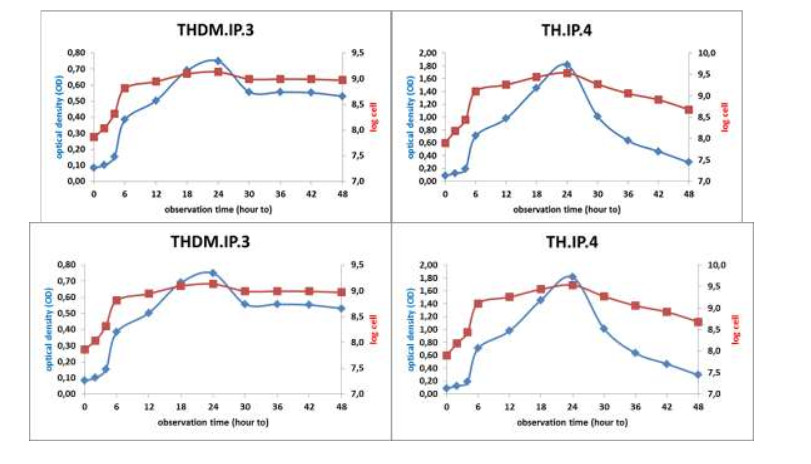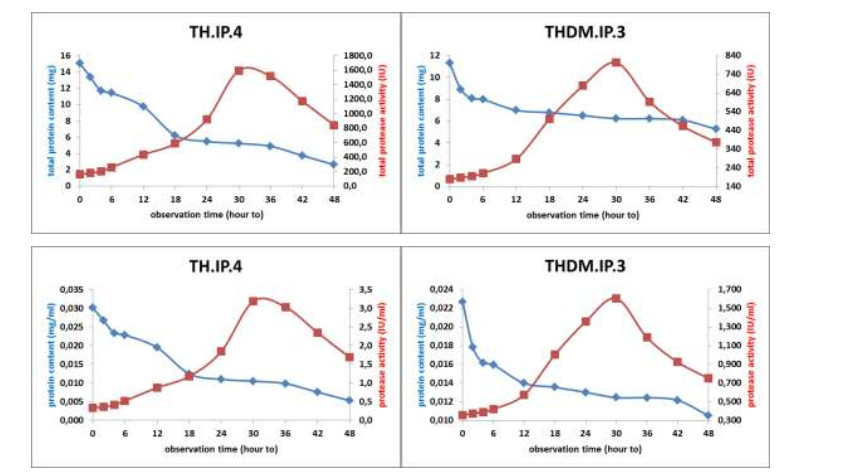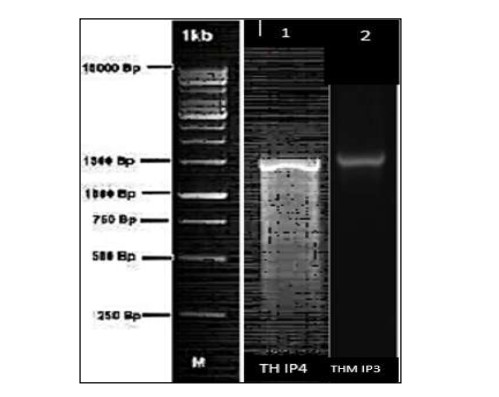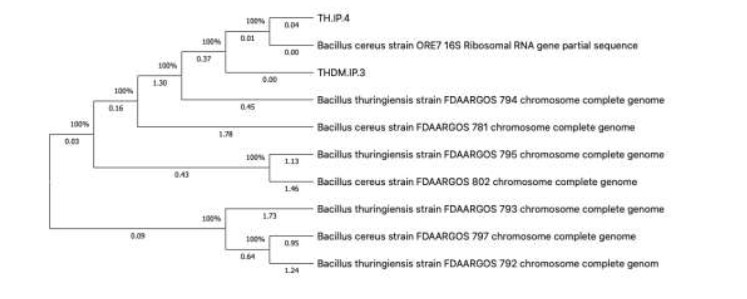This research aims to determine the characteristics of extra-cellular protease enzymes derived from the intestines of sea cucumbers as a candidate for bio-detergent, to optimize the growth of extra-cellular protease-producing bacteria and to identify the enzymes producing bacteria by DNA sequencing. The study consisted of 5 stages, namely isolation, selection and identification of extra-cellular protease-producing bacterial enzymes, bacterial growth optimization test in the production of extra-cellular protease enzymes, enzyme isolation and characterization, enzyme ability testing of various detergent components and determining the highest conditions of enzyme activity, and purification and identification from the extra-cellular protease enzyme. The results showed that bacteria isolated from the sea cucumbers Stichopus hermanni, Holothuria atra and H.leucopilota. Bacterial isolation derived from the contents of all these sea cucumbers produced 60 isolates and 22 isolates were active against the enzyme protease. Optimization test of carbon compounds (C), namely glucose, fructose, and molasses produces the enzyme molasses. Nitrate (N) compounds optimization test, namely: Ammonium chloride, Ammonium nitrate, Urea found Ammonium nitrate as the best. Optimization test results of the concentration of substances C, N and optimization on the parameters of salinity (25, 30, 35 ppt), pH (6, 7, 8) and temperature (25, 30, 35℃), produced the best salinity at 30 ppt, the best ph at 8 and the best temperature at 30 ℃. The results of the fermentation test showed that protein hydrolysis in TH.IP.4 isolate media was better than that in THDM.IP.3. There was a positive correlation between cell density and the presence of protease enzymes, where the higher the number of cells, the higher the production of protease enzymes. Protease activity in TH.IP.4 isolates was better than THDM.IP.3 isolates. Molecular identification results showed that isolate 0TH.IP.4 had the closest match (99%) with Bacillus cereus and THDM.IP.3 was a complete match (100%) with Bacillus thuringiensis.
1.
Introduction
Enzymes have been the most important part in the development and improvement of detergent products for years. Industrial and Institutional Organizations (I & I) have contributed to shortening washing times and reducing energy consumption through decreasing temperature and pH. Enzymes are environmentally friendly catalysts and are effective to add to detergent formulas. The development of genetic and protein engineering plays an important role in increasing the potential, stability, and specificity for industrial enzyme products. The mechanism for removing stains and impurities can be carried out by surfactants, builders, and enzymes. Alkaline proteinase in detergent formulas can hydrolyze impurities attached to the fabric. Surfactants play an important role in reducing surface tension at the interface and increasing repulsion forces between impurities. The addition of enzymes allows the degradation of dirt and stains. The addition of builders triggers the exchange of calcium ions and magnesium salts, provides alkalinity, and prevents redeposition of impurities [1].
Protease has the potential to be used in industry because this enzyme can be found in marine organisms, such as sea cucumbers that are filter feeders. The enzymes with the mucosa are thought to be produced by the epithelium layer [2]. Mucus and enzymes together break down chemical compounds from food particles along the digestive tract. There are 25 kinds of enzymes in sea cucumbers from the species Leptosynapta gallinnei and Leptosynapta inhaerens. Five types of enzymes are able to decompose the chain of ester compounds, 12 types are able to decompose glycoside chains, and 8 types able to decompose the chain of peptide compounds. These twenty five types of enzymes can be grouped into disaccharides, polysaccharides, amylase, maltase, protease, esterease, and chitinase. Protease activity was observed in bacteria found in the intestines of Holothuria atra and Holothuria leucospilota [3,4].
The use of bacteria in the production of proteases has several advantages including being easily produced on a large scale, relatively short reproduction time, and can be produced continuously at a relatively low cost [5]. Based on the explanation above, the research objective is to determine the results of isolation and selection of extra-cellular protease producing bacteria, optimization of bacterial growth in enzyme production and identification of extra-cellular protease producing bacteria by DNA method.
2.
Materials and method
2.1. Isolation and purification of bacteria
The method used in growing bacteria was pour plate. Sea cucumber stomach samples are taken and weighed up to 10 grams and put into an erlenmeyer flask containing 90 mL of sterile saline water (70%), and rotated in a vortex machine until homogeneity and dilution 10-1 are obtained. Furthermore, from10-1, 10-2, 10-3, 10-4, 10-5 and 10-6. Each dilution was placed in a pour-plate filled with Zobell 2216E agar media and was incubated for 2x24 hours at room temperature. The morphology of the colony was identified and maintenance of pure culture was carried out, which then the results were stored at -80 oC [6].
2.2. Proteolytic doting activity test and agar diffusion proteolytic activity test
Qualitative test of the ability of proteolytic enzyme-producing bacterial isolates was performed by the doting procedure according to Bairagi [7]. Test the ability of proteolytic enzymes-producing bacterial isolates was performed by a procedure referred to in Bairagi [7]. The method used in the growth of active protease isolates follows the procedure [8].
2.3. Scoring of the best active protease isolates
Scoring in selecting the best isolates is done in several stages, namely determining the class of data, weighing, scoring and ranking. The data class is determined by determining the minimum and maximum values so that a range of data is obtained (the difference in value between the minimum and maximum data). Afterwards the difference is divided into not suitable, suitable and very suitable class ranges. The weighing is done by assigning data values based on the type of variable. Weight 1 is the number and time of generation (tertiary variables), weight 3 is the growth rate (secondary variable) and weight 6 is the diameter of the proteolytic zone (primary variable). Scores are obtained by multiplying data groups by data weights. The score of each variable is brought up to a sum to obtain a total score. The total scores are then collated into a ranking system. The selected isolates from the top 10 rank were then processed in the next stage of the test until the 5 best isolates remained. From the five isolates, the 2 best isolates were selected.
2.4. Selection of carbon and nitrogen sources
Nutrient selection which includes carbon and nitrogen sources is carried out using a modified method in Polak-Berecka [8]. The selected carbon sources are glucose, fructose and molasses as co-substrates in the Zobell 2216E medium based on biomass production. A carbon source of 1% is introduced into the Zobell 2216E medium. The selected nitrogen sources are ammonium chloride, ammonium nitrate and urea as co-substrate based on biomass production. A nitrogen source of 0.2% is introduced into the Zobell 2216E medium. Selection of carbon sources and nitrogen sources was carried out with a media that was adjusted to a pH of 7.0. The culture medium (200 mL) in an Erlenmeyer flask was inoculated with a starter isolate which gave OD 0.01 on A600. It was then incubated at a room temperature. In a 6-hour interval for 48 hours, a sample of 4 mL was taken and OD measurements were taken at A600. OD data are used in determining cell density values, orthogonal polynomial analysis and linear regression analysis. Cell density data in the exponential phase is used to determine the value of growth rate, number and time of generation. The three data are then tested using one way ANOVA and Tukey post-hoc test. Data on growth rate, amount and time of generation are used to determine the right carbon and nitrogen sources for growth.
2.5. Optimization of carbon and nitrogen sources, pH, salinity and temperature
Carbon and nitrogen sources that have been tested in subsequent experiments are used in concentration optimization experiments in the Zobell 2216E medium (9), after which OD measurements are taken at A600 (10). Carbon and nitrogen sources were introduced into the Zobell 2216E liquid medium with optimum concentrations, according to the orientation experiments, in an Erlenmeyer flask that had been inoculated with starter isolate, which gave OD 0.01 on A600. The optimal pH, salinity and temperature for growth are determined using the methods in Subagyo et al., (2015). In a 6-hour interval for 48 hours, a sample of 4 mL was taken and OD measurements were taken at A600 (Anderson & Vijayakumar, 2012). OD data were obtained by measuring cell density values, orthogonal polynomial analysis and linear regression analysis. Cell density data in the exponential phase is used to determine the value of the growth rate (Kc), count of bacterial generation (G) and time of generation (Tg). The three data are then processed using the one-way ANOVA and Tukey post-hoc test. Data on growth rate, number and time of generation are used to determine the optimal pH for growth.
2.6. Quantitative test of protein hydrolysis in fermentors and Identification of bacterial molecular DNA
The quantitative test of protein hydrolysis in the fermenter was carried out according to the references in Membre. J-M et al. 2005. DNA methods for selecting the best bacteria include DNA isolation and purification (11). amplification of 16S rRNA gene (Marchesi et al., 1998), electrophoresis and sequencing, BLAST homology analysis (http://www.ddbj.nig.ac.jp/) and phylogenetic tree analysis (12).
3.
Result and discussion
Isolation of sea cucumber symbiont bacteria. The results found 3 species of sea cucumbers that can be used as subjects, namely golden sea cucumbers (S. hermanni), black sea cucumbers (H. atra) and black Tarzan (H. leucopilota). The results of the isolation of 3 species of sea cucumbers, 65 bacterial isolates were found dominated with the color beige and circular, irregular and rhizoid morphology. Then from 60 isolates tested with proteolytic enzymes, 22 isolates were filtered.
Optimization of proteolytic bacteria growth as target isolates. Isolates from the results of qualitative proteolytic enzymes were used in quantitative tests of proteolytic bacteria by the agar diffusion method. Protease activity test results with this method were set to be the protein hydrolysis zone data. Furthermore, the bacterial growth test produces optical density (OD) data which is an important element of polynomial analysis in determining the kinetics trend of bacterial growth. OD data on exponential trends were analyzed by linear regression method to obtain the growth equation and correlation coefficient (R) values. OD data conversion was achieved using McFarland standard equation, which results in bacterial cell density data. Data on bacterial cell density functions to calculate the value of the number of bacterial generation (G), generation time (Tg) and growth rate (Kc) in the normality, homogeneity, additive, one-way ANOVA and Tukey post-hoc tests. The average proteolytic zone results (G, Tg and Kc) were used in determining the score of each isolate in ranking the 10 best isolates, namely: THDM.IP.3, TH.IP.4, THDM.IP.2, TG.IP.8, TG.IP.3, THDM.IP.4, TG.IP.1, TG.IP.9, TG.IP.10, TH.IP.9.
From the screening of 10 isolates, a C source selection test was carried out which included source C treatment, namely control, glucose, fructose, and molasses treatments. The results showed that the best source of Carbon is the Molasses, which was always higher in value than the control treatment on the cell growth rate (Kc) test value, as presented in Table 1.
Nitrogen (N) elements include ammonium chloride, ammonium nitrate, urea and controls. The results showed that the best Nitrogen source was found in the ammonium nitrate co-substrate, which was always higher in value than the control on the cell growth rate (Kc) test value, as presented in Table 2.
The results of screening of the elements C and N found 5 isolates with the best score in the molasses and ammonium nitrate co-substrate at the cell growth rate (Kc), namely: THP IP4, THDM IP 3, THDM IP2, TG IP3 and TG IP 8 as presented in Table 5.
Screened isolates, namely: THP IP4, THDM IP 3, THDM IP2, TG IP3 and TG IP 8 were then used in an optimization test of the concentration of molasses and ammonium nitrate respectively, at a concentration of: Molasses: 0.5%, 1% and 1.5% and ammonium nitrate: 0.1%, 0.2% and 0.3%. Molasses optimization test results at each concentration (0.5%, 1% and 1.5%) show that the molasses concentration of 1% was the best at cell growth rate (Kc), as presented in the Table 3.
Ammonium nitrate optimization test results at each concentration (0.1%, 0.2% and 0.3%) show that the ammonium nitrate concentration of 0.1% was the best at cell growth rate (Kc), as presented in the Table 4.
Screened isolate samples, namely: THP IP4, THDm IP 3, THDM IP2, TG IP3 and TG IP 8 was used in optimization tests in salinity, pH and temperature, of which results would be determined as further reference data. Salinity optimization test results at each concentration (°/oo) (20, 25, 30) showed that the salinity 30°/oo was the best at cell growth rate (Kc), as presented in the Table 5.
pH optimization test results at each level (6, 7 and 8) showed that the pH 8 was the best at cell growth rate (Kc), as presented in the Table 6.
Optimization test results at each temperature (25, 30, and 35 ℃) showed that the 35 ℃ was the best temperature for cell growth rate (Kc), as presented in the Table 7.
Samples from the enzyme optimization test of molasses (1%) and ammonium nitrate (0.1% and optimization tests on salinity parameters (30 °/oo), pH (8) and temperature (35 ℃) of the 5 isolates THP IP4, THDM IP 3, THDM IP2, TG IP3 and TG IP 8, showed results as presented in Table 5, table 6, Table 7, Table 8 and Table 9. To get the candidate isolate bacteria with the best protease potential, a scoring of 5 protease-active isolates conducted to obtain the final value specified in three criteria, namely not suitable, suitable and very suitable. Samples with the best potential as proteolytic isolates were then tested in a quantitative hydrolysis protein test. The results of this test are presented in Table 8.
Scoring results for the best proteolytic bacterial candidates were then used in quantitative tests of protein hydrolysis. The test produced 2 of the best isolates, on which further tests were carried out on the growth and activity of proteases in the fermenter. Fermenter tests were carried out to obtain OD data, dry biomass of bacterial cells, protease activity, total protease activity, specific protease activity, protein content, and total protein content. The growth value, protein hydrolysis and the production of extra-cellular protease enzymes are determined by the polynomial analysis.
The growth of the 2 isolates in fermenter. The results of the growth research of TH.IP.4 and THDM.IP.3 isolates in fermenters found different growth trends. The growth of isolate TH.IP.4 showed phase lag at hour 0 to 4 (OD 0.09-0.19) and exponential growth phase at hour 4 to 24 (OD 0.19-1, 81), where the peak bacterial density occurred at hour 24 and did not show stationary phase. Finally, the bacterial growth had deteriorated (OD 0.29) after 48 hours (Figure 1)
The growth of isolate THDM.IP.3 showed phase lag at hour 0 to 4 (OD 0.08 - 0.15) and its exponential growth phase occurred at hour 4 to 18 (OD 0.15 - 0.69). The stationary phase of the growth of this isolate occurred at the hour 18 to hour 24 (OD 0.69 - 0.75). Bacterial growth experienced peak density at hour 24, with an OD value measured at 0.75. Finally, at hour 48 (OD 0.53) the bacterial growth had deteriorated, as presented in Figure 1.
These findings showed the difference in biomass of cell growth between isolates TH.IP.4 and THDM.IP.3. Dry cell biomass in TH.IP.4 isolate was of greater value than that in THDM.IP.3 isolate. However, the growth trend of dry cell biomass of the two isolates showed a linear correlation with the growth trend of bacterial OD values. The value of the growth rate shows that the growth of TH.IP.4 isolate (Kc = 0.157 ± 0.001 b*) was higher than that of isolate THDM.IP.3 (Kc = 0.121 ± 0.001 a) as presented in Figure 2 and Table 9.
Protease activity of isolates TH.IP.4 and THDM.IP.3 in fermenter. The protein content and total protein media values in isolates TH.IP.4 and THDM.IP.3 showed linear declination, which could be described by the equation y = -0.2376x + 12.926 (R2 = 0.9056) and y = -0.0843x + 9.0107 (R2 = 0.7096). Decreased levels and total protein in TH.IP.4 (Sloop 0.2376) were higher than that in THDM.IP.3 (Sloop 0.0843). This finding meant that the protein hydrolysis in TH.IP.4 isolate media was better than that in THDM.IP.3. These results showed that the total protease activity in TH.IP.4 and THDM.IP.3 was polynomial (Figure 3). The total protease of isolate TH.IP.4 could be described by the polynomial equation y = -0.9442x2 + 68.608x - 36.819 (R2 = 0.8082) and that of THDM.IP.3 by the polynomial equation y = -0.6627x2 + 38.446x + 74.853 (R2 = 0.8307). The protease activity in isolate TH.IP.4 could be summarized by the polynomial equation y = -0.0019x2 + 68.608x - 0.0736 (R2 = 0.8082) while that in THDM.IP.3 by the polynomial equation y = -0.0013x2 + 38.446x + 0.1497 (R2 = 0.8307). The pattern is in line with the pattern found in cell growth kinetics. This finding confirms a positive relationship between cell density and the presence of the protease enzyme. Correlation of cell density and the presence of protease enzymes in TH.IP.4 isolates can be expressed in the equation y = 3.5209x + 0.2168 (R2 = 0.8473) and that in THDM.IP.3 with y = 1.3927x + 0.2253 (R2 = 0.9203). In this correlation, the higher the number of cells, the higher the production of the enzyme protease. This phenomenon eventually contributes to greater protein hydrolysis. TH.IP.4 protease activity was rated better than THDM.IP.3, with sloop values of 0.1372 and 0.0769, respectively.
Identification of Bacteria. The DNA amplification of TH.IP.4 and THDM.IP.3 isolates is presented in Figure 4. Isolates TH.IP.4 and THDM.IP.3 produced a single band of 1500 bp (base pair) in comparison to the DNA markers. Showed base lengths of 250, 500, 1000, and 1500 respectively from the bottom up. Electrophoresis results data is presented in Figure 4.
The homology search results of 16S rDNA sequences TH.IP.4 and THDM.IP.3 isolates in the Gene Bank database using BLAST are presented in Figure 4 and Table 11. Whereas homology tracing of bacterial isolates in the Genbank database are presented in Table 11.
The high value of the relation between TH.IP.4 isolates and sequences in the database (>95%) indicated that at least the molecular identification is close to match at the genus level. The isolate THDM.IP.3 obtained a perfect match value (100%) on search.
Formula with the addition of enzymes has been widely used in various detergent products in liquid, paste and powder form. Enzymes such as amylase, protease, lipase and cellulase have become indispensable additives in detergents. Research has found that sea cucumber symbiotic bacteria indicate protease enzyme activity, especially in carbon sources with co-substrate molasses and in nitrate sources with ammonium nitrate co-substrates. Protease acts as a major component in detergents and can easily hydrolyze protein residues [13]. The findings of this study have the potential to be used as enzymes which lowers toxicity, are more environmentally friendly, and enhance efficiency as well as stability.
The most optimal parameters were indicated at 30 °/oo for salinity, 8 for pH and 30 ℃ for temperature. High temperature alkaline pH supports detergent bio-industry because these parameters are very suitable in the removal of impurities. Protease is one of the most important enzymes in the industry and accounts for around 40% of total industrial enzyme sales[2,14]. Demand for proteolytic industry enzymes with specificity and stability of pH, temperature, metal ions, surfactants, and organic solvents continues to drive the search for the latest enzyme sources. Protease with high activity and stability in the range of basic pH and high temperature is very promising in its application in the field of biotechnology. Alkaline proteinase is widely used as an additive material in detergents to facilitate the release of protein [2,14].
The species Bacillus cereus and Bacillus thuringiensis were determined as the symbiotic bacteria in sea cucumbers with protease activity. B acillus cereus consisted of seven, closely-related species: B. cereus sensu stricto (referred to in this study as B. cereus), B. anthracis, B. thuringiensis, B. mycoides, B. pseudomycoides, and B. cytotoxicus [15]. Bacillus cereus is a gram-positive, rod-shaped, facultative-anaerobic, motile, beta-hemolytic, spore-forming species found mostly in soil and food [16,17,18]. One study found that the unique and specific proteins produced by B. cereus can eliminate N-alkali bases, and do not show activity in oxidized base lesions [19], making B. cereus a potential source of raw material for detergent industry.
Bacillus thuringiensis produces metalloproteases and serine alkaline proteases (endogenous), which influence sporulation and entomotoxicity of different insect orders. Various interactions between protease and crystal poisons at different levels are known (sporulation and insecticide actions) [20]. This finding shows that B. thuringiensis is also a potential species to be used as a source of raw material for detergent industry.
The use of proteases in the detergent industry has grown to a large and commercial scale. Protease is one of the raw materials for all types of detergents used in households. The use of protease in laundry detergents accounts for around 25% of total enzyme sales worldwide [21]. The first enzymatic detergent production took place in 1913, under the trade name Burnus, which consisted of sodium carbonate and crude pancreas extracts [21]. The first detergent containing bacterial enzymes was introduced in 1956, under the trade name BIO-40. Novo Industries in the United States first introduced the alcalase from Bacillus licheniformis, under the commercial name BIOTEX. Protease from B. cereus BM1 is reported to be very promising as an additive enzyme for detergents. Enzymes added to the formula of a detergent must be able to retain their activities in a solution containing commercial detergent up to 10% w/v.
4.
Conclusion
This study concluded that there were 2 isolates with the best potential for proteolitik isolates, namely isolate THDM IP 3 and THP IP4. Isolate TH.IP.4 was closely matched (99 %) to the species Bacillus cereus whereas isolate THDM.IP.3 showed complete match (100 %) with the species Bacillus thuringiensis. TH.IP.4 protease activity was rated better than THDM.IP.3, with sloop values of 0.1372 and 0.0769, respectively.
Acknowledgments
This research is supported by grants from Hibah Penelitian FPIK SK: 032/IJN7.5. I 0.2/PP/2020. The authors would like to extend the deepest gratitude to the leaders of Diponegoro University, dean of the Faculty of Fisheries and Marine Sciences for facilitating the research. We would also like to thank Amelia Cahaya Anggelina for her assistance in the laboratory.
Conflict of interest
The authors have no conflict of interest.









 DownLoad:
DownLoad:







